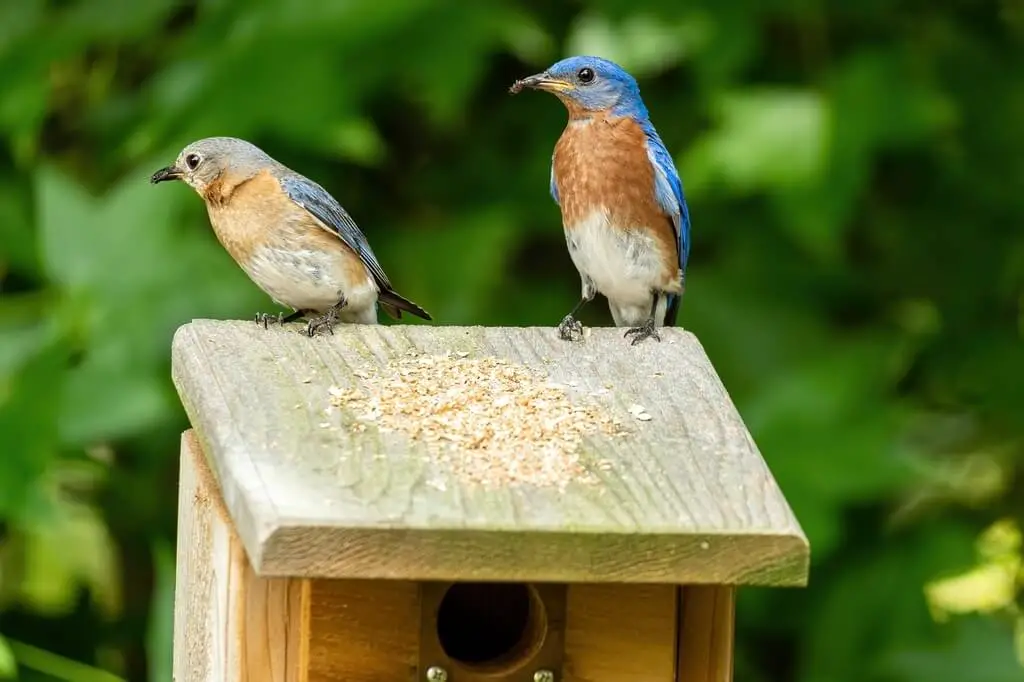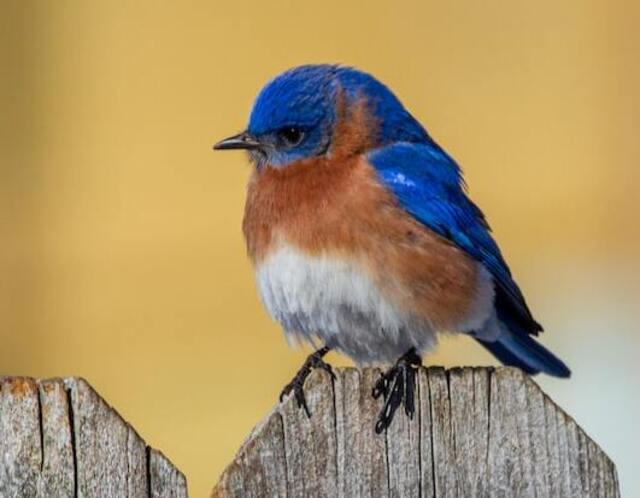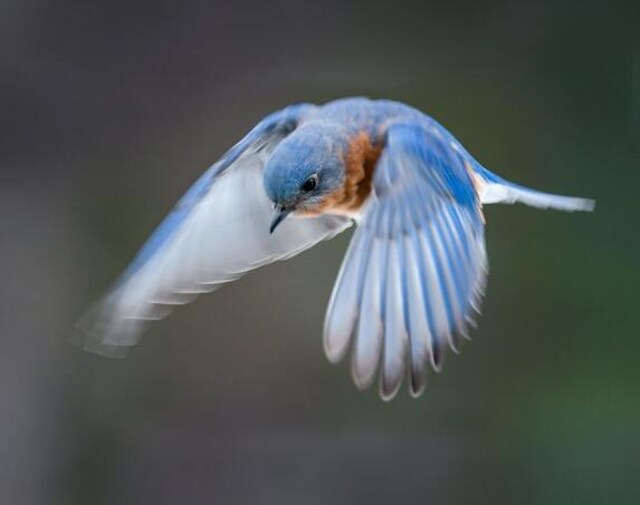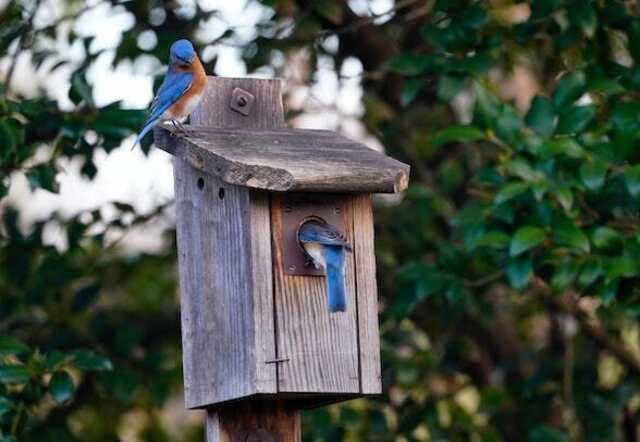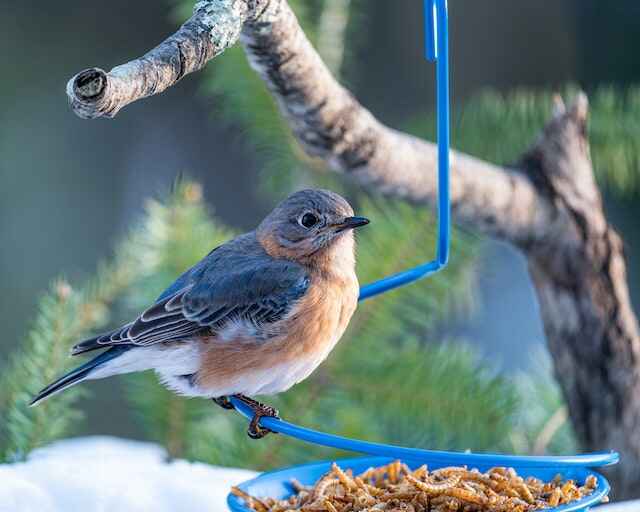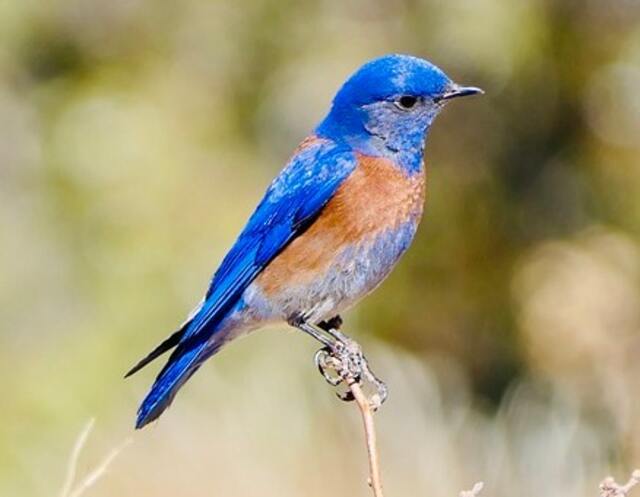If you’re looking to attract Eastern Bluebirds to your yard, it’s important to understand their habits and preferences. These beautiful birds are known for their vibrant blue color and are a joy to watch.
By creating an appealing habitat, providing suitable housing and optimizing your feeders, you can encourage them to frequent your yard.
In this article, we’ll provide an overview of how to attract Eastern Bluebirds to your yard. We’ll discuss their habits and preferences, as well as provide tips on creating an enticing habitat for them.
Table of Contents
- 1 Key Takeaways:
- 2 How to Attract Eastern Bluebirds to your Yard?
- 3 Understanding Eastern Bluebirds’ Habits and Preferences
- 4 Creating an Ideal Habitat for Eastern Bluebirds
- 5 Optimizing Feeders for Eastern Bluebirds
- 6 Landscaping Tips for Attracting Eastern Bluebirds
- 7 Creating a Bluebird-Friendly Environment
- 8 Dealing with Potential Challenges
- 9 Monitoring and Enjoying Eastern Bluebirds in your Yard
- 10 Bluebird Conservation Efforts
- 11 Conclusion
- 12 FAQs: How to Attract Eastern Bluebirds to your Yard?
- 12.1 Can I attract Eastern Bluebirds to my yard without providing housing?
- 12.2 What type of food should I put in my bluebird feeder?
- 12.3 How can I create a bluebird-friendly environment?
- 12.4 What are some potential challenges in attracting Eastern Bluebirds?
- 12.5 How can I monitor and enjoy Eastern Bluebirds in my yard?
- 12.6 How can I contribute to bluebird conservation efforts?
- 13 Author
Key Takeaways:
- Understanding the habits and preferences of Eastern Bluebirds can help create an environment that appeals to them.
- Providing suitable housing such as bluebird houses and nesting boxes is important to attract and support their nesting needs.
- Optimizing feeders with the right food and types of feeders can enhance their chances to frequent your yard.
| Aspect | Eastern Blue BIrd Overview |
|---|---|
| Identification | The Eastern Bluebird has brilliant blue upper parts, rusty throat and breast, and white lower belly. |
| Length | 6.3-8.3 in (16-21 cm) |
| Weight | 1.0-1.1 oz (28-32 g) |
| Wingspan | 9.8-12.6 in (25-32 cm) |
| Range | Originally found throughout eastern and central North America, now primarily in the eastern U.S. and southeastern Canada. |
| Habitat | Deciduous forests, gardens, orchards, hedgerows, and open spaces with shrubs, providing nesting cover. |
How to Attract Eastern Bluebirds to your Yard?
To attract Eastern Bluebirds to your yard, provide them with a suitable habitat and food. Bluebirds prefer open areas with short grass and nearby trees or shrubs for perching. Install a nest box with a 1.5-inch entrance hole and place it in a sunny location, about 5–6 feet off the ground.
Offer mealworms, suet, and fruit in a platform feeder. Avoid using pesticides and herbicides as they can harm bluebirds and their food sources. Provide a water source for drinking and bathing. With patience and persistence, you can attract these beautiful birds to your yard.
Understanding Eastern Bluebirds’ Habits and Preferences
Attracting Eastern Bluebirds to your yard requires understanding their natural behavior and preferences. These birds are cavity nesters and tend to prefer open spaces with grassy areas and scattered trees.
Providing a suitable bluebird habitat is crucial to attracting these birds to your yard. A habitat with natural food sources, such as insects, caterpillars, and berries, will also appeal to them.
Creating the Ideal Bluebird Habitat
| Aspect | Description |
|---|---|
| Open Space | Eastern Bluebirds prefer open areas with short grass and scattered trees. Maintain an open area of at least 100 square feet. |
| Nesting Sites | Provide suitable nesting sites by installing bluebird houses or nesting boxes in open areas away from trees and buildings. |
| Food Sources | Offer natural food sources, such as insects, caterpillars, and berries. Consider planting native fruit-bearing trees and shrubs. |
| Water | Supply a shallow birdbath or water feature for Eastern Bluebirds to drink and bathe in. |
Creating an ideal habitat for Eastern Bluebirds can also attract other wildlife to your yard. Providing a diverse range of habitats can attract different species of birds and other wildlife.
Next, we will discuss how to provide suitable housing for Eastern Bluebirds to encourage nesting and breeding.
Creating an Ideal Habitat for Eastern Bluebirds
To attract Eastern Bluebirds to your yard, creating an ideal habitat that caters to their nesting needs is crucial. Providing suitable housing such as bluebird houses and nesting boxes is essential for successful bluebird attraction.
| Bluebird Houses | Nesting Boxes |
|---|---|
| A bluebird house is a specially designed dwelling that offers a safe and secure place for Eastern Bluebirds to nest. It is essential to place these houses in areas that are free from exposure to predators, and they should be set up facing away from the prevailing winds. | Nesting boxes provide bluebirds with an alternative means of nesting. These boxes should be placed along fence lines, edges of woodlands, or near open fields. The entrance hole should be about 1.5 inches in diameter, and the box should be three to five feet off the ground. |
Both bluebird houses and nesting boxes should be made of untreated wood, preferably cedar or pine. It is also crucial to ensure that the houses are regularly cleaned and maintained to prevent the spread of diseases.
By providing suitable housing, you can create a hospitable environment for Eastern Bluebirds, increasing the likelihood of them nesting in your yard.
Optimizing Feeders for Eastern Bluebirds
Eastern Bluebirds are primarily insectivores, but they also eat fruits and berries. To attract them to your yard, it’s important to provide a variety of food options. Here are some tips for optimizing your feeders:
- Mealworms: These are a favorite of Eastern Bluebirds and can be purchased live or freeze-dried. Offer mealworms in a shallow dish or specialized mealworm feeder.
- Suet: Suet cakes can attract a variety of birds, including Eastern Bluebirds. Look for suet cakes that contain insects or fruits.
- Fruits and Berries: Offer fresh or dried fruits, such as blueberries or raisins, in a tray feeder or on a platform feeder.
- Insects: Insect-filled feeders can attract Eastern Bluebirds, as well as other insect-eating birds. Look for feeders that contain mealworms, crickets, or other insects.
When selecting feeders for Eastern Bluebirds, choose those with small openings to prevent larger birds from stealing the food. Additionally, avoid using feeders with perches, as Eastern Bluebirds prefer to cling to the sides of the feeder.
One of my favorite ways to attract them is with this Poly Lumber Bluebird Feeder. You just have fill it with mealworms and watch the bluebirds come. You can pick it up on Amazon.
Remember to clean your feeders regularly to prevent the spread of disease. Use a solution of one part bleach to nine parts water to disinfect your feeder and rinse thoroughly before refilling.
Landscaping Tips for Attracting Eastern Bluebirds
Landscaping plays a significant role in attracting birds to your yard, including Eastern Bluebirds. The right combination of plants, trees, and water features can create an inviting environment that appeals to these stunning birds.
Choose Native Plants that Attract Birds
Selecting the right plants is crucial to creating a bird-friendly landscape. Native plants are ideal, as they are adapted to the local climate and provide food and shelter for birds. Some excellent choices include:
- Serviceberry
- Winterberry
- American Holly
- Blueberry
- Elderberry
These plants produce fruits that Eastern Bluebirds love to eat, making them an attractive option for your yard.
Create a Water Feature
Eastern Bluebirds are attracted to water features, such as bird baths or a small pond. Adding a water source to your yard can also attract other kinds of birds, making your yard a prime destination for birdwatching.
Provide Nesting Sites
Eastern Bluebirds prefer to nest in cavities, such as those found in dead trees. Providing nesting boxes is an excellent way to attract them to your yard. Make sure the entry hole is the right size and that the box is mounted at the right height. This will increase the chances of Eastern Bluebirds using it as a nesting site.
Design for Diversity
Designing your yard for diversity in plants and habitats is crucial to attracting a variety of wildlife, including Eastern Bluebirds. Create different layers of vegetation, such as understory, mid-story, and canopy trees. This will provide a range of habitats for birds to live and feed in.
By implementing these landscaping tips, you can create an inviting habitat that attracts Eastern Bluebirds and other birds to your yard. With a little planning and effort, you can enjoy the beauty of these stunning birds in your own backyard.
Creating a Bluebird-Friendly Environment
If you want to attract Eastern Bluebirds to your yard, it’s essential to create an environment that appeals to them. While providing housing and feeders are great places to start, you can do more to create a bluebird-friendly environment.
Plant Native Trees and Shrubs
Eastern Bluebirds prefer to nest near open areas with scattered trees and shrubs. Planting native trees and shrubs in your yard can create the ideal habitat for them. Consider planting dogwood, eastern red cedar, or sumac trees, and provide nesting sites in the form of shrubs like American beautyberry and New Jersey tea. Not only will these plants give bluebirds a place to nest and hunt for insects, but they’ll also attract a variety of other wildlife to your yard.
Provide Water
Eastern Bluebirds enjoy bathing in shallow water sources, so consider adding a birdbath or shallow water feature to your yard. Not only will a water source attract bluebirds, but it will also provide drinking and bathing opportunities for other bird species. Get the lowest price for the Alpine Bird Bath on Amazon.
Create a Safe Haven
Eastern Bluebirds are preyed upon by a variety of predators, so providing a safe haven for them is crucial. Avoid using pesticides in your yard, as they can harm not only bluebirds but also their food sources. Additionally, consider adding brush piles or a thicket of dense shrubs to offer a safe place for them to hide from predators.
By creating a bluebird-friendly environment in your yard, you’ll not only attract these beautiful birds but also contribute to their conservation efforts. With a little effort and planning, you can create a haven for these stunning creatures and enjoy their presence in your yard.
Dealing with Potential Challenges
While creating a bluebird-friendly environment, it’s important to be mindful of potential challenges that could hinder your efforts to attract Eastern Bluebirds to your yard. Here are some common obstacles and solutions:
| Challenge | Solution |
|---|---|
| Predators, such as cats, snakes, or squirrels, that can harm the birds or their eggs and young. | Install predator guards on your bluebird houses and nesting boxes to keep out unwanted visitors. You can also place a wire cage around the box, allowing only smaller birds to enter. |
| Nesting competition from other birds, such as house sparrows or starlings, that may take over the bluebird house or box. | Regularly monitor your bluebird houses and boxes, and remove any nests or eggs of unwanted bird species. Provide multiple nesting options to decrease competition. |
| Harsh weather conditions, such as extreme heat or cold, that could harm the birds or affect their food sources. | Provide a reliable source of water and choose plants that provide shelter and berries to sustain bluebirds through unfavorable weather conditions. |
Overcoming these challenges will ensure a safe and sustainable environment for Eastern Bluebirds, increasing your chances of attracting them to your yard.
Monitoring and Enjoying Eastern Bluebirds in your Yard
Once you have successfully attracted Eastern Bluebirds to your yard, monitoring and enjoying their presence can be a delightful experience. Here are a few tips to make the most out of observing these beautiful birds:
- Observe their behavior: Take note of their actions, such as the way they interact with each other or how they use the feeders and nesting boxes. This can provide insight into their habits and preferences.
- Document their visits: Keep a record of when they visit your yard and what they do while they’re there. This can be a fun project to involve children or to simply keep track of their comings and goings.
- Enjoy their song: Eastern Bluebirds have a distinctive and pleasant song. Take some time to listen and enjoy their melodic tunes.
Remember to respect the birds and their environment. Avoid disturbing their nests or habitat and maintain a safe distance when observing or taking photographs. Enjoy the beauty of these feathered wonders from afar.
Bluebird Conservation Efforts
Creating a bluebird-friendly environment goes hand in hand with supporting the conservation of these beautiful birds. Eastern Bluebirds face a number of threats, including habitat loss and competition for nesting sites with non-native species such as House Sparrows and European Starlings.
To counter these challenges, there are several conservation organizations that are working to protect the habitat of Eastern Bluebirds. The North American Bluebird Society is a non-profit organization that promotes the conservation of bluebirds and their habitats.
They offer a wealth of information on bluebird conservation, including tips on building and installing bluebird houses, as well as monitoring and reporting bluebird populations. Another organization, the Cornell Lab of Ornithology, sponsors a Bluebird Nest Box Trail project, where volunteers monitor bluebird nesting sites and collect data on breeding success and population trends.
As a bluebird enthusiast, you can contribute to conservation efforts by supporting organizations like the North American Bluebird Society, participating in citizen science projects like the Bluebird Nest Box Trail, and educating others on the importance of bluebird conservation. Your efforts can make a difference in ensuring the continued success of these iconic birds.
Conclusion
Attracting Eastern Bluebirds to your yard can be a rewarding experience for both you and the birds. By understanding their habits and preferences, creating an ideal habitat, optimizing feeders, and landscaping appropriately, you can make your yard an attractive destination for these stunning birds.
Additionally, monitoring and enjoying their presence can bring joy and excitement to your daily routine. It’s important to also remember the importance of contributing to bluebird conservation efforts through supporting organizations and participating in citizen science projects.
Ultimately, creating a bluebird-friendly environment is not only necessary for attracting bluebirds, but for preserving their population and habitat for years to come. Whether you’re a seasoned birder or new to the hobby, attracting Eastern Bluebirds is a great way to connect with nature and enhance your outdoor space.
FAQs: How to Attract Eastern Bluebirds to your Yard?
Can I attract Eastern Bluebirds to my yard without providing housing?
While it is possible for Eastern Bluebirds to visit yards without specific housing, providing suitable housing such as bluebird houses or nesting boxes greatly increases the likelihood of attracting them to your yard.
What type of food should I put in my bluebird feeder?
Eastern Bluebirds are insectivores, so offering mealworms or other live or dried insects is the most appealing food option for them. Avoid using seeds or bread in bluebird feeders as they do not typically consume these foods.
How can I create a bluebird-friendly environment?
Creating a bluebird-friendly environment involves providing suitable housing, optimizing feeders, selecting appropriate plants for landscaping, and minimizing potential risks such as predators or pesticides.
What are some potential challenges in attracting Eastern Bluebirds?
Some challenges you may encounter include competition from other bird species, predation, and unfavorable weather conditions. By addressing these challenges and implementing appropriate solutions, you can increase your chances of attracting Eastern Bluebirds.
How can I monitor and enjoy Eastern Bluebirds in my yard?
You can monitor Eastern Bluebirds by observing their behaviors, keeping a logbook, and participating in citizen science projects. Enjoy their presence by providing a comfortable viewing area and documenting their visits through photography or video.
How can I contribute to bluebird conservation efforts?
Supporting conservation organizations that focus on bluebird conservation and participating in citizen science projects such as nest box monitoring can contribute to the preservation of the Eastern Bluebird’s habitat.

